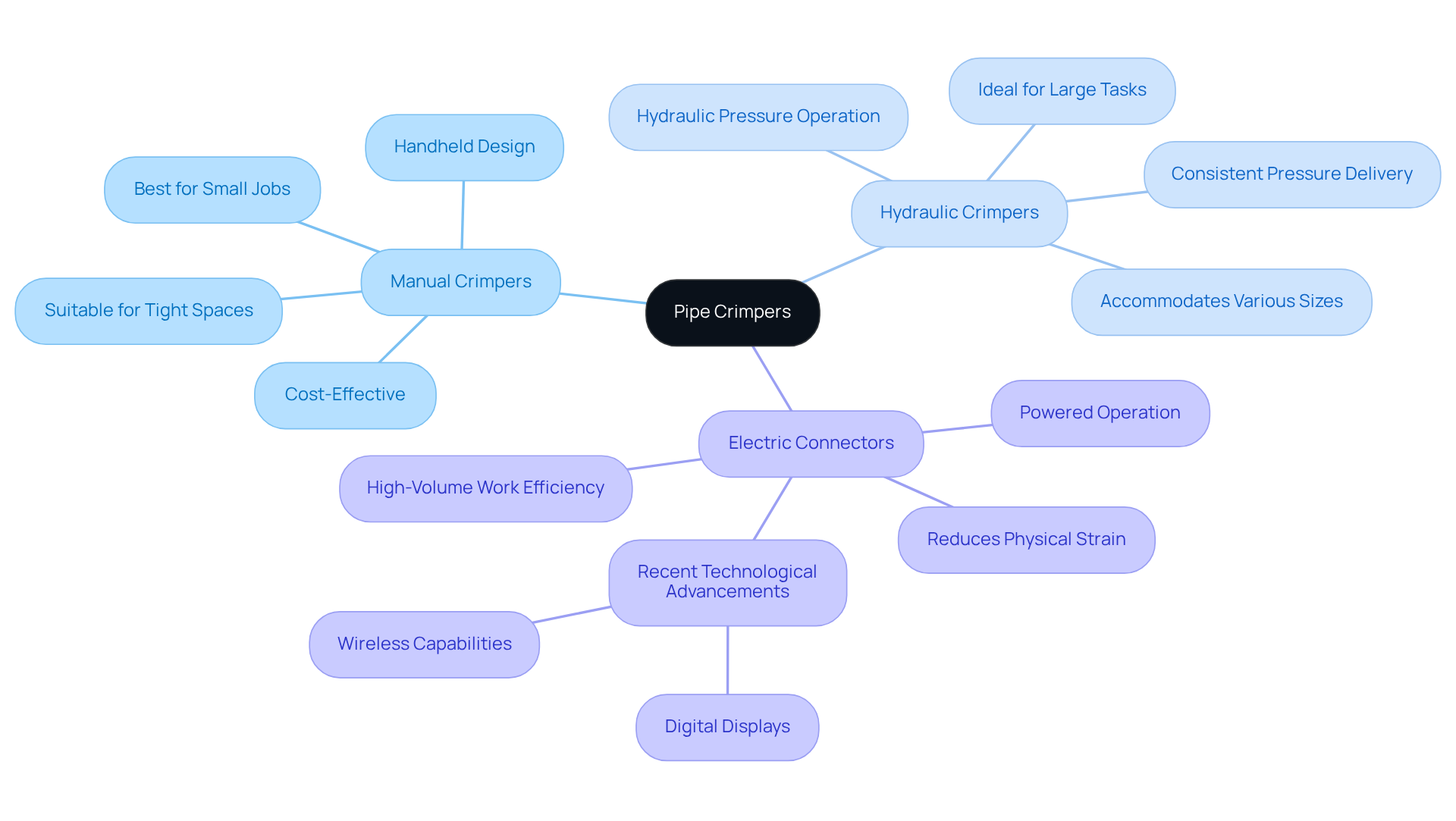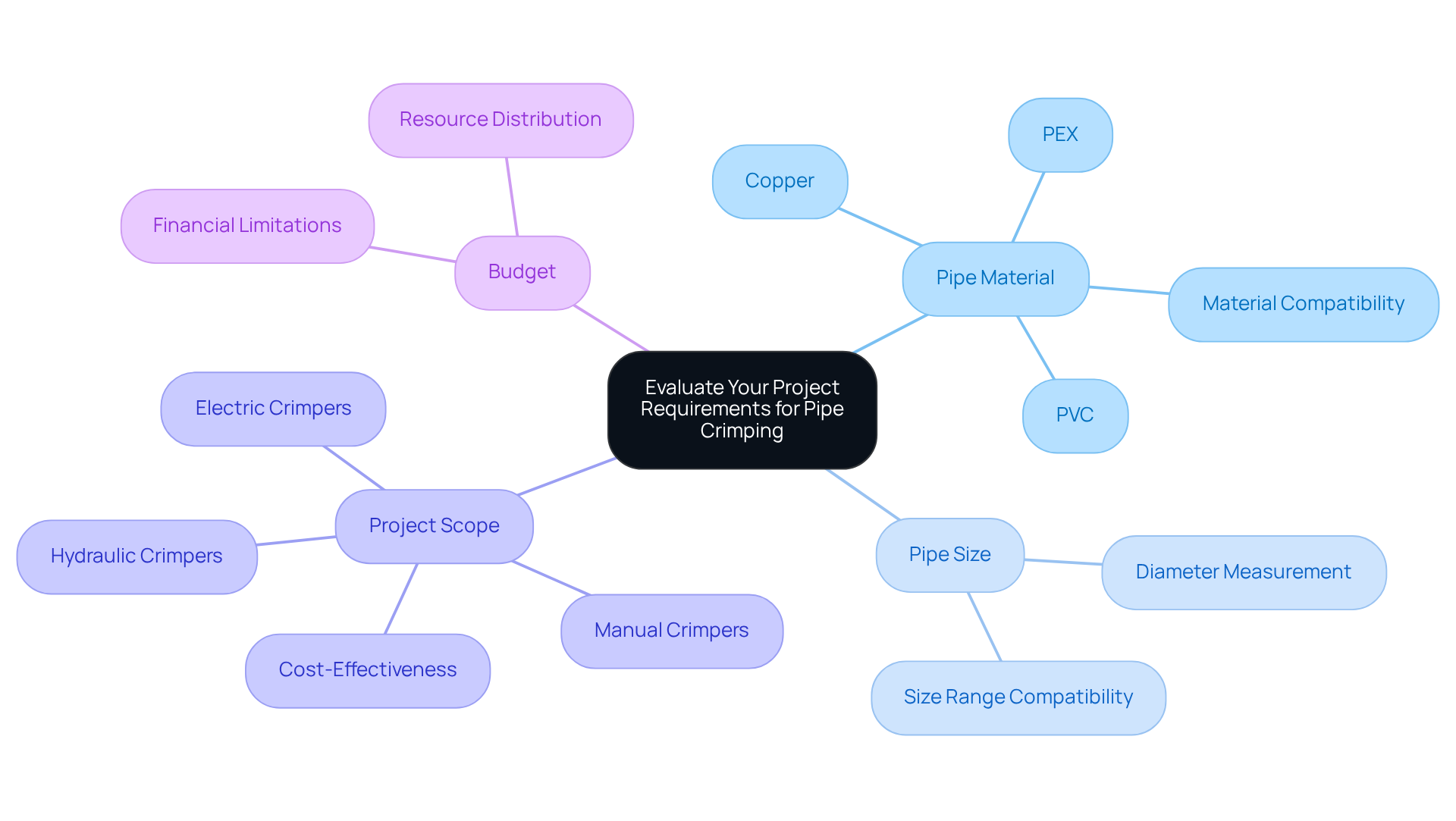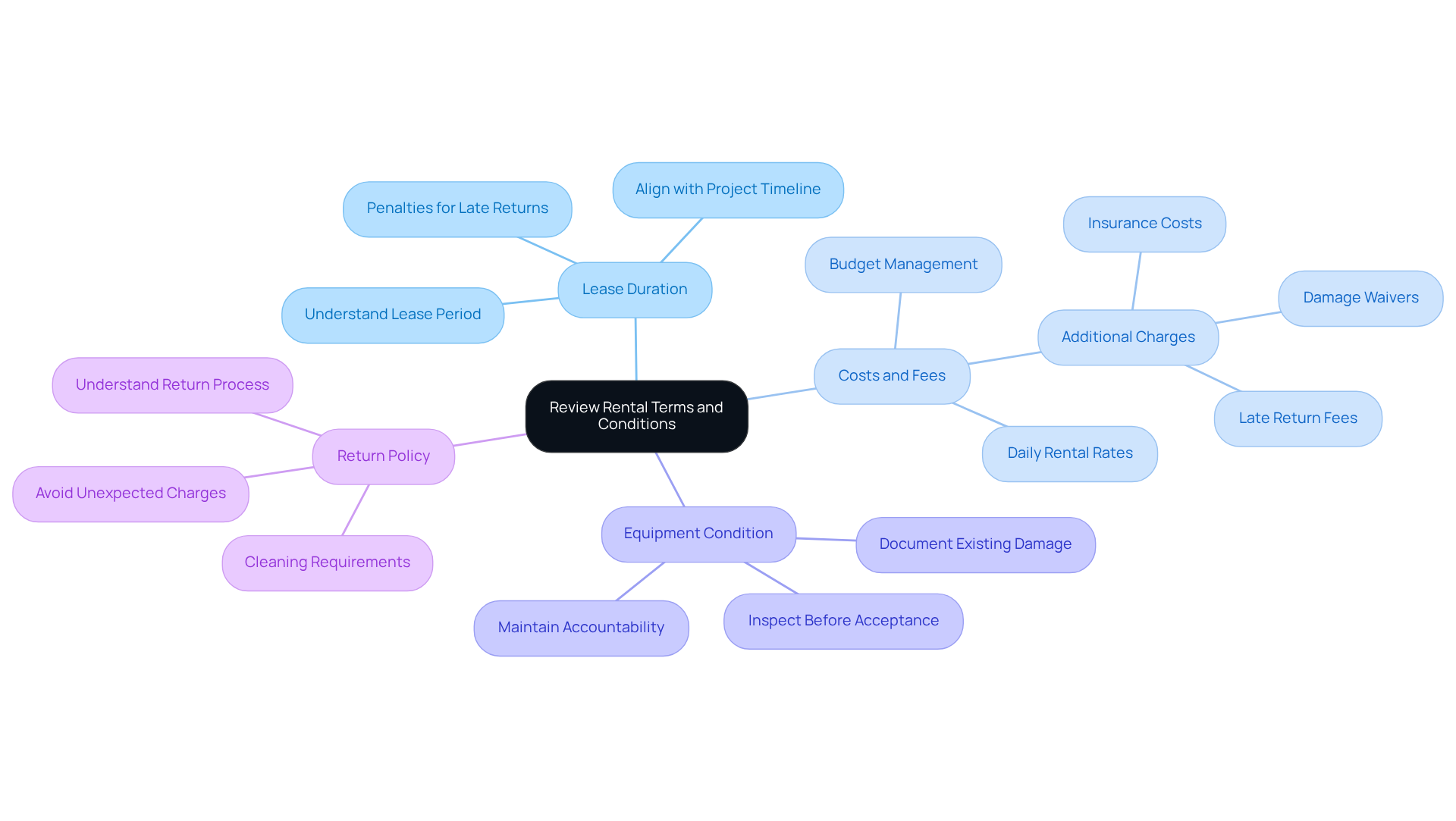Overview
Successful pipe crimper rental involves four essential steps:
- Evaluating project requirements
- Reviewing rental terms
- Adhering to a structured rental process
- Conducting a thorough inspection of the equipment
First, it is crucial to assess the specific needs of your project, including the type of pipe material and size. Understanding these factors, alongside your budget, ensures that you select the most suitable equipment.
Furthermore, a thorough inspection of the equipment prior to rental is vital to confirm its reliability and functionality. By following these guidelines, you not only enhance project outcomes but also ensure that you are utilizing the right tools effectively.
Ultimately, adhering to lease agreements further solidifies a successful rental experience.
Key Highlights:
- Pipe crimpers are essential for creating secure connexions in plumbing and HVAC applications.
- Types of crimpers include manual (for small jobs), hydraulic (for larger tasks), and electric (for high-volume work).
- Manual crimpers are cost-effective and suitable for tight spaces, while hydraulic crimpers provide consistent pressure for extensive installations.
- Electric crimpers enhance efficiency with features like digital displays and wireless capabilities.
- Considerations before renting include pipe material compatibility, pipe size, project scope, and budget.
- Review rental terms carefully, focusing on lease duration, costs, equipment condition, and return policy.
- Steps to rent a pipe crimper from EZ Equipment Rental include checking availability, completing the lease agreement, inspecting the tool, and ensuring proper return.
Introduction
In the plumbing and HVAC industries, having the right tools is crucial; it can mean the difference between a successful project and a costly failure. Among these tools, pipe crimpers stand out as essential for creating secure and leak-proof connections. They come in various types, each tailored for specific tasks and materials, ensuring that every job is handled with precision. Understanding the nuances of these tools is vital for anyone considering renting a crimper. However, many individuals encounter challenges when selecting the right equipment to meet their unique project needs.
So, how can one ensure they make the best choice and navigate the rental process smoothly?
Understand Pipe Crimpers: Types and Functions
Pipe squeezing tools are indispensable for establishing secure, leak-proof connections between pipes and fittings, which is crucial for plumbing and HVAC applications. The primary types of crimpers include:
-
Manual Crimpers: These handheld tools require physical strength, making them best suited for smaller jobs and tight spaces. Their simplicity and cost-effectiveness make them a preferred choice among DIY enthusiasts and professionals alike.
-
Hydraulic Crimpers: Utilizing hydraulic pressure, these tools are engineered for larger tasks that necessitate greater force. They accommodate various pipe sizes and materials, rendering them ideal for extensive plumbing installations. Their ability to deliver consistent pressure ensures reliable connections, vital for preventing leaks and maintaining system integrity. For example, hydraulic tools are frequently employed in large-scale plumbing projects where resilience and power are essential.
-
Electric Connectors: These powered tools provide consistent pressure, making them ideal for high-volume work. They significantly reduce physical strain on the user while enhancing efficiency, which has led to their rising popularity in modern construction settings. Recent advancements in electric crimping technology feature digital displays for real-time feedback on pressure levels and wireless capabilities that enhance mobility on job sites. Such innovations not only boost accuracy and performance but also align with the growing trend towards automation in the construction industry.
The market for connectors is evolving, with hydraulic and electric models gaining traction due to their efficiency and effectiveness in demanding applications. Understanding these categories will empower you to select the appropriate tool, including a pipe crimper rental, based on your specific needs, ensuring optimal outcomes and enhancing overall efficiency.

Evaluate Your Project Requirements for Pipe Crimping
Before opting for a pipe crimper rental, it is essential to thoroughly evaluate your project requirements by considering several key factors.
-
Pipe Material: Different materials, such as copper, PEX, and PVC, necessitate specific crimping tools. It is crucial to confirm that the crimper you select is compatible with the material you are working with to ensure optimal performance. As the plumbing tubing industry is projected to expand at a 14.69% CAGR, understanding material compatibility is increasingly important.
-
Pipe Size: Accurately measuring the diameter of the pipes you will be crimping is vital. This measurement is essential for choosing a tool that can handle the required size range for your task, as incorrect sizing can lead to inefficient crimping. Remember, "By failing to prepare, you are preparing to fail," as Benjamin Franklin wisely stated.
-
Project Scope: Assessing the scale of your project is also critical. For larger undertakings, utilizing a pipe crimper rental of hydraulic or electric crimpers may enhance efficiency and speed, while smaller jobs might only require manual crimpers, which are often more cost-effective. The demand for plumbing services is fueled by aging infrastructure and energy-efficient upgrades, making it vital to choose the right tool for the job.
-
Budget: Establishing a clear budget for your rental is essential. Understanding your financial limitations will assist you in selecting the appropriate tool without exceeding your budget, enabling more effective resource distribution during your endeavor. As mentioned, "Every minute spent in planning saves 10 minutes in execution," highlighting the significance of budgeting in management.
By thoughtfully evaluating these elements, you can ensure that you select the most appropriate tool for your specific requirements. Incorporating structured planning, as highlighted in the case study "The Necessity of a Game Plan," can further enhance your project's success.

Review Rental Terms and Conditions for Pipe Crimpers
When renting a pipe crimper, it is essential to thoroughly review the rental terms and conditions, paying close attention to the following key aspects:
-
Lease Duration: Clearly understand the lease period and any penalties associated with late returns. Ensure that the leasing duration aligns with your project timeline to avoid unnecessary costs. This understanding is crucial to prevent complications later on.
-
Costs and Fees: Familiarize yourself with the leasing fees for pipe crimper rental, including potential additional charges for insurance, damage waivers, or late returns. Clarifying these costs upfront is crucial to prevent budget overruns and ensure effective cost management. Common fees may include daily rental rates, which can range significantly based on the equipment type. Knowing these details will empower you to make informed decisions.
-
Equipment Condition: Inspect the tool before accepting it. Document any existing damage to protect yourself from being held responsible for it upon return. This step is vital for maintaining accountability and ensuring the equipment's integrity. A thorough inspection can save you from unexpected disputes later.
-
Return Policy: Understand the return process, including any requirements for cleaning or maintenance before returning the equipment. Knowing these details in advance can streamline the return and help avoid unexpected charges. Being prepared for the return process ensures a smooth transaction and fosters a positive rental experience.

Follow Steps to Rent a Pipe Crimper from EZ Equipment Rental
To rent a pipe crimper from EZ Equipment Rental, follow these steps to ensure a smooth and efficient process:
- Visit the EZ Equipment Leasing Website: Begin by exploring the available tools online or visit our leasing center in Irving, TX. Our store hours are Monday to Friday from 7:30 AM to 5:30 PM and Saturday from 7:30 AM to 5:00 PM. We are closed on Sundays.
- Check Availability: Ensure the specific pipe crimper rental you need is available for your desired borrowing period. Call (214) 951-7800 for prompt assistance from our knowledgeable team, ready to support you throughout the leasing process.
- Complete the Lease Agreement: Fill out the lease agreement, providing necessary identification and payment details. Examine the terms and conditions thoroughly, noting our flexible leasing options and competitive pricing that facilitate access to the equipment you require.
- Examine the Tools: Before leaving the leasing center, check the tool for any damage and confirm it meets your task requirements. Our team is here to assist you with any questions during this step.
- Return the Equipment: After completing your project, return the crimper according to the rental agreement, ensuring it is clean and in good condition to avoid additional fees. Your satisfaction is our priority, and we appreciate your commitment to returning the equipment in excellent shape.
Conclusion
Understanding the intricacies of pipe crimper rentals is essential for ensuring project success in plumbing and HVAC applications. Selecting the right tool—whether manual, hydraulic, or electric—can significantly impact the efficiency and effectiveness of your work. By making informed decisions based on your project requirements, you can optimize performance and minimize potential issues.
Key considerations include:
- Assessing the type and size of pipes
- Understanding the scope of your project
- Establishing a clear budget
Furthermore, reviewing rental terms and conditions is crucial to avoid unexpected costs and ensure a smooth rental experience. By following the structured steps outlined for renting from EZ Equipment Rental, you can navigate the process confidently, ensuring that you have the right equipment for your needs.
Ultimately, the significance of careful planning and informed decision-making cannot be overstated. As the demand for efficient plumbing services continues to grow, adopting a proactive approach to tool selection and rental can lead to successful project outcomes. Embrace the opportunity to enhance your skills and efficiency by utilizing the right pipe crimper for your next venture.
Frequently Asked Questions
What are pipe crimpers used for?
Pipe crimpers are used to establish secure, leak-proof connections between pipes and fittings, which is crucial for plumbing and HVAC applications.
What are the main types of pipe crimpers?
The main types of pipe crimpers include manual crimpers, hydraulic crimpers, and electric connectors.
What are manual crimpers and when are they best used?
Manual crimpers are handheld tools that require physical strength, making them best suited for smaller jobs and tight spaces. They are simple and cost-effective, appealing to both DIY enthusiasts and professionals.
How do hydraulic crimpers work and what are their advantages?
Hydraulic crimpers utilize hydraulic pressure to perform larger tasks that require greater force. They accommodate various pipe sizes and materials, making them ideal for extensive plumbing installations. Their ability to deliver consistent pressure ensures reliable connections, which is vital for preventing leaks.
What are electric connectors and what benefits do they offer?
Electric connectors are powered tools that provide consistent pressure, making them ideal for high-volume work. They reduce physical strain on the user and enhance efficiency, featuring advancements like digital displays for real-time feedback on pressure levels and wireless capabilities for better mobility.
Why are hydraulic and electric crimpers becoming more popular?
Hydraulic and electric crimpers are gaining traction due to their efficiency and effectiveness in demanding applications, aligning with the growing trend towards automation in the construction industry.
How can understanding different types of pipe crimpers help in choosing the right tool?
Understanding the different categories of pipe crimpers empowers you to select the appropriate tool based on your specific needs, ensuring optimal outcomes and enhancing overall efficiency.




